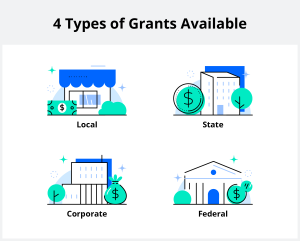
Are you a student in Canada burdened by the weight of student loans? Well, we’ve got some good news for you! In this blog post, we will be diving into the world of student loan grants in Canada.
Yes, you read that right – grants that could potentially help alleviate your financial stress and pave the way to a brighter future. Join us as we explore these hidden gems, uncovering how they work, who is eligible, and where to find them.
Get ready to embark on an exciting journey towards debt relief and unlocking new opportunities – because education should never come at an unmanageable cost!
Introduction to Student Loan Grants in Canada
Contents
Student loan grants are a type of financial aid that can help you pay for college or university. Unlike loans, grants do not have to be repaid. Grants can come from the federal government, your province or territory, or from private sources such as banks, foundations, or businesses.
The Canadian government offers two types of student loan grants: the Canada Student Grant for full-time students and the Canada Student Grant for part-time students. You may be eligible for a grant if you meet certain criteria, such as being a Canadian citizen or permanent resident, having financial need, and being enrolled in an eligible program at a designated post-secondary institution.
If you are a full-time student with financial need, you could receive up to $5,000 per academic year through the Canada Student Grant for Full-Time Students. If you are a part-time student with financial need, you could receive up to $1,500 per academic year through the Canada Student Grant for Part-Time Students. These grant amounts are based on your assessed financial need and whether you are studying in a low-income family or have dependents.
To apply for either of these grants, you must complete the Free Application for Federal Student Aid (FAFSA). You will also need to provide information about your parents’ or guardians’ finances if you are under 19 years of age or if your parents live in Canada but don’t file taxes here. The FAFSA is available online at the Government of Canada website.
Eligibility Requirements
To be eligible for student loan grants in Canada, you must:
- Be a Canadian citizen or permanent resident.
- Demonstrate financial need.
- Enroll in an approved program of study at a designated post-secondary institution.
- Not be in default on any previous student loans.
- Meet the specific eligibility criteria of the granting agency or institution
providing the grant or loan.
How to Apply for a Grant?
- There are many grants available to Canadian students seeking financial assistance for their education. To apply for a grant, you will need to fill out an application form and submit it to the government agency or organization that provides the grant.
- The application process is usually competitive, so you will need to make sure that your application is well-written and complete. You will also need to provide supporting documentation, such as transcripts, financial statements, and letters of recommendation.
- If you are awarded a grant, you will typically receive the funds directly from the organization or government agency. The payments are usually made in installments, and you may be required to repay the grant if you do not complete your education or meet other conditions set by the funding organization.
- Applying for a grant can be a time-consuming process, but it is worth it if you can secure funding for your education. With careful planning and a strong application, you can increase your chances of being awarded a student loan grant.
Good luck!

The Process of Receiving a Grant
Receiving a grant can be a lengthy process, but it’s important to be aware of the steps involved so that you can be prepared. Here’s an overview of what you can expect:
- The first step is to research which grants are available to you. There are many different types of grants, so it’s important to find the one that best suits your needs. The Canadian government website is a good place to start your search.
- Once you’ve found a grant that you’re eligible for, the next step is to complete the application form. This can usually be done online, and you’ll need to provide some basic information about yourself and your financial situation.
- Once your application has been submitted, it will be reviewed by the granting organization. If they decide to award you the grant, they will contact you with further instructions on how to receive the money.
- Once you’ve received the grant money, it’s up to you to use it by the terms laid out by the organization. Typically, this means using it towards educational expenses such as tuition or textbooks.
- Finally, you must submit a report to the granting organization at the end of the term or year to show how the funds were used and document any outcomes or results that were achieved.
Types of Grants Available
There are a variety of grants available to students in Canada. The type of grant you may be eligible for depends on your financial need and the province or territory in which you reside.
- Federal Grants: The Government of Canada offers two types of federal student grants: needs-based grants and equipment grants. Needs-based grants are awarded based on your demonstrated financial need, while equipment grants are intended to help cover the cost of educational materials and equipment such as computers.
- Provincial and Territorial Grants: In addition to federal student grants, each province and territory in Canada has its program of student financial assistance. Contact your provincial or territorial student financial assistance office to learn more about the types of grants available in your area.
- Aboriginal Grants: If you are an Aboriginal person, you may be eligible for special funding through the Aboriginal Student Funding Program. This program provides need-based grants as well as scholarships and bursaries to First Nations, Inuit, and Métis students across Canada.
- Private Grants: In addition to government-funded grants, there are a variety of private grants available for students in Canada. These grants may come from universities, employers, charitable organizations, and other sources. Check with your school or research online to learn about the various types of private grants you may be eligible for.

Advantages and Disadvantages of Student Loan Grants in Canada
The Canadian government offers student loan grants to eligible students to help them pay for their education. Grants are need-based, and the amount of the grant is based on the student’s financial need.
There are several advantages to receiving a student loan grant.
- The first is that grants do not have to be repaid, unlike loans. This can save the student a significant amount of money in the long run.
- Additionally, grants can often be used to cover expenses such as tuition, books, and living expenses, which can make attending college or university more affordable.
There are also some disadvantages to receiving a student loan grant.
- One is that the amount of the grant may not be enough to cover all of the expenses associated with attending college or university.
- Additionally, grants are typically only available to full-time students, so part-time students may not be eligible for this type of financial aid.
Tips for Making the Most Out of Your Grant
Tips for Making the Most Out of Your Grant
Once you have been awarded a student loan grant, it’s important to make sure that you use it in a way that will benefit your future. Here are some tips on how to make the most out of your grant:
- Use Your Grant to Pay for Necessities: Make sure to use your grant money for necessary expenses such as tuition, books, and living expenses. Avoid using it for things like entertainment or vacations, as this could put you in a difficult financial situation later on.
- Research Other Scholarship Opportunities: You should also make sure to research other scholarship opportunities that may be available to you. This can help you maximize the amount of money you receive from grants and scholarships combined.
- Consider Repayment Options: If you need to take out a loan to cover the costs of your education, make sure to look into repayment options that could potentially reduce the amount of interest you pay over time.
- Take Advantage of Tax Credits: You should also consider taking advantage of tax credits available for post-secondary students in Canada. These credits can help reduce the amount of taxes you owe and provide additional savings for your education costs.
- Stay Organized: Lastly, staying organized is key when managing student loan grants and other forms of aid for post-secondary education. Make sure to track your expenses and keep receipts of all payments so that you can easily keep track of where your money is going.
Student loan grants in Canada can be a great way to help reduce the cost of post-secondary education. If you’re applying for a grant, make sure to use the tips above to ensure that you make the most out of it!
Conclusion
Student loan grants in Canada are a great way for students to access the funds they need to pursue higher education. By researching and understanding the different types of grants available, you can ensure that you are applying for the most suitable one for your situation.
It is important to remember that there are certain criteria and deadlines attached to each grant program so make sure that you read all of these before applying. With careful planning, student loan grants can be an invaluable asset in helping Canadian students finance their post-secondary studies.